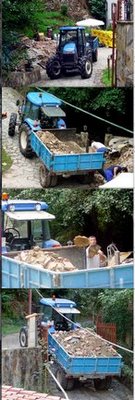
There must be a hundred sayings in Spanish that have the word bread in them. My favorite is "Eres mas bueno que el pan," which translates literally as "You are better than bread," and is usually said while cupping the face of an adorable child in your hands and squeezing. Or alternatively, "Eres mas inocente que el pan"--"You're more innocent than bread."
But the dirty secret for a country that puts such a premium on bread as to compare it to goodness itself is that most Spanish bread is not very good. Your standard barra is cottony and bland and even the rustic-looking gallego is disappointingly flavorless and unchewy. It's true that La Tahona, near us on c/Humilladero, has me convinced it's the best bakery in Madrid because of its delicious chapata, but even it turns out standards--barras and baguettes--that just don't do it for me. I can only conclude that Spaniards like bad bread.
But Galparsoro, in San Sebastian, changed my mind this past week. They appear to supply barras to half the city; in the morning their deliverymen pull huge woven baskets stuffed with loaves on handcarts through the Parte Vieja. But it is their specialty breads that really stand out. Gorgeous chapatas and rusticas and vienesas. A dense, slightly sour mushroom-shaped thing called a Plus Minus. And what are certainly the best brioche I've eaten outside Paris. But the star, the shocking star, of their offerings is the humble suizo, a normally uninteresting sweet roll topped with sugar. At Galparsoro, the dough is chewy and yeasty and not too sweet; the sugar on top comes in big crunchy crystals. Early Tuesday morning I ate one warm from the oven as I walked along the seawall. It was, indeed, mas bueno que el pan.
Galparsoro: Nagusia 6, San Sebastian.











